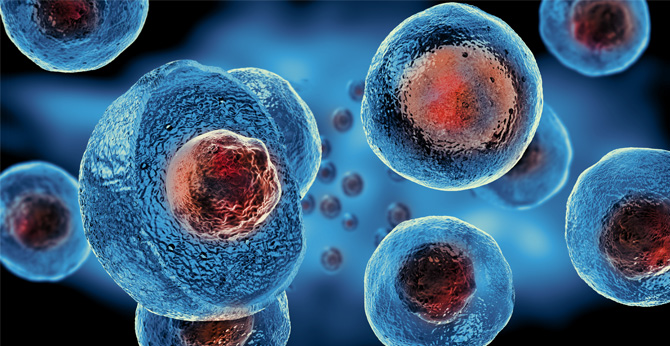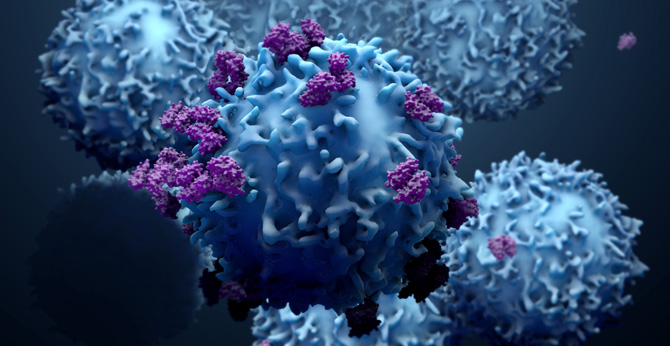All products and services are For Research Use Only and CANNOT be used in the treatment or diagnosis of disease.
Here are the products related to CD123 CAR, so you can choose the one that will be useful for your research project!
IL-3 is a pleiotropic interleukin cytokine produced primarily by activated T lymphocytes. It mainly regulates the function and production of hematopoietic cells and immune cells. The IL-3 receptor (IL-3R) is a heterodimer composed of α and β chains, and CD123 is the α chain of the interleukin 3 receptor (IL-3Rα). Studies have shown that CD123 is overexpressed on a variety of tumor cells and plays a role in promoting the excessive proliferation of tumor cells. As a result, CD123 has emerged as an attractive novel therapeutic target for hematological malignancies.
 Fig.1 Schematic diagram of the structure of CD123.1
Fig.1 Schematic diagram of the structure of CD123.1
Plasmacytoid Dendritic Cell Tumor
Acute Lymphoblastic Leukemia/Lymphoma
Hairy Cell Leukemia
Systemic Mastocytosis
With an advanced technology platform and strong scientific research strength, Creative Biolabs constructs effective and stable CD123 CAR-T cells for you through CAR molecular structure design, T-cell transfection, CAR-T cell identification, etc.
 Fig.2 Schematic diagram of CD123 CAR construction.2
Fig.2 Schematic diagram of CD123 CAR construction.2
Anti-CD123 CAR-T Cytokine Release Test
Cytokine Release Syndrome (CRS) can cause microvascular system damage, and cytokines such as IFN-γ and IL-6 are released in large quantities, which can promote each other with the coagulation activation process, and finally form multi-organ failure. There are many cytokines associated with CRS, but a few are particularly critical, namely IL-2, IFN-γ, IL-6, and IL-10.
 Fig.3 IFN-γ levels of CD123 CAR-T in the supernatant after cell co-culture.2
Fig.3 IFN-γ levels of CD123 CAR-T in the supernatant after cell co-culture.2
Anti-CD123 CAR-T In Vitro Cytotoxicity Assay
Creative Biolabs offers cytotoxicity assays to measure the cancer cell-killing capacity of effector cells. The four most commonly used assays are chromium (51 chromium) release assays, luciferase-mediated bioluminescence imaging assays, impedance-based assays, and flow cytometry assays.
 Fig.4 Assessment of the CD123 CAR-T cytotoxicity. The results showed a significant reduction in CD123 CAR-T-induced CB cell death.2
Fig.4 Assessment of the CD123 CAR-T cytotoxicity. The results showed a significant reduction in CD123 CAR-T-induced CB cell death.2
Anti-CD123 CAR-T Cell Therapy Animal Models
Due to species differences, there are problems such as species specificity of CAR-T cells and tumor targets, xenograft-versus-host responses, and difficulties in mimicking human immune responses in animals, and the selection of appropriate animal models is crucial for the proof of concept of CAR-T cell function. Creative Biolabs offers humanized mouse models to help you test information about the efficacy, distribution, and proliferation characteristics of CAR-T cells in vivo.
 Fig.5 In vivo study of CD123 CAR-T in NSG mice.2
Fig.5 In vivo study of CD123 CAR-T in NSG mice.2
Efficacy Test of Anti-CD123 CAR-T
In vivo efficacy assessment is essential to study the factors that influence the efficacy of CAR-T. Creative Biolabs offers a range of in vivo pharmacodynamic evaluation services for CD123 CAR-T to provide a scientific basis for your preclinical studies.
 Fig.6 Efficacy of CD123 CAR-T treated NSG mice. The results showed that CD123 CAR-T effectively eliminated leukemia.2
Fig.6 Efficacy of CD123 CAR-T treated NSG mice. The results showed that CD123 CAR-T effectively eliminated leukemia.2
Viability Study of Anti-CD123 CAR-T
Creative Biolabs offers a range of CD123 CAR-T viability study services, including but not limited to in vivo proliferation and survival assays, T cell migration and distribution, memory T cell responses, and more.
 Fig.7 Survival curves of CD123 CAR-T treated with PDX-AML2. The results showed that CD123 CAR-T treatment significantly prolonged the overall survival of PDX-AML2.2
Fig.7 Survival curves of CD123 CAR-T treated with PDX-AML2. The results showed that CD123 CAR-T treatment significantly prolonged the overall survival of PDX-AML2.2
References
 Loading...
Loading...
| CAT | Product Name | Target Species | Antibody Clone | Antibody Host | Receptor Construction | Vector Type | Targeting Cell Type | CAR Vector Type | Inquiry & Datasheet |
| CAR-YF023 | Anti-CD123 (CBL-YF004) h(4-1BB-CD3ζ) CAR, pCDCAR1 | Human | CBL-YF004 | Humanized | scFv-4-1BB-CD3ζ | Lentiviral vector | T cell | ||
| CAR-YF024 | Anti-CD123 (CBL-YF004) h(CD28-CD3ζ) CAR, pCDCAR1 | Human | CBL-YF004 | Humanized | scFv-CD28-CD3ζ | Lentiviral vector | T cell | ||
| XS-0323-LX445 | Anti-CD123 VHH(X3XH76) h(ICOS-41BB-CD3ζ) CAR, pCDCAR1 Vector | Human | X3XH76 | VHH-ICOS-4-1BB-CD3ζ | Lentiviral vector | T cell | CAR-T | ||
| XS-0323-LX446 | Anti-CD123 VHH(X3XH77) h(ICOS-41BB-CD3ζ) CAR, pCDCAR1 Vector | Human | X3XH77 | VHH-ICOS-4-1BB-CD3ζ | Lentiviral vector | T cell | CAR-T | ||
| XS-0323-LX805 | Anti-CD123 VHH(X3XH67) h(CD28-OX40-CD3ζ) CAR, pCDCAR1 Vector | Human | X3XH67 | VHH-CD28-OX40-CD3ζ | Lentiviral vector | T cell | CAR-T | ||
| XS-0323-LX806 | Anti-CD123 VHH(X3XH68) h(CD28-OX40-CD3ζ) CAR, pCDCAR1 Vector | Human | X3XH68 | VHH-CD28-OX40-CD3ζ | Lentiviral vector | T cell | CAR-T | ||
| XS-0323-LX807 | Anti-CD123 VHH(X3XH69) h(CD28-OX40-CD3ζ) CAR, pCDCAR1 Vector | Human | X3XH69 | VHH-CD28-OX40-CD3ζ | Lentiviral vector | T cell | CAR-T | ||
| XS-0323-LX808 | Anti-CD123 VHH(X3XH70) h(CD28-OX40-CD3ζ) CAR, pCDCAR1 Vector | Human | X3XH70 | VHH-CD28-OX40-CD3ζ | Lentiviral vector | T cell | CAR-T | ||
| XS-0323-LX809 | Anti-CD123 VHH(X3XH71) h(CD28-OX40-CD3ζ) CAR, pCDCAR1 Vector | Human | X3XH71 | VHH-CD28-OX40-CD3ζ | Lentiviral vector | T cell | CAR-T | ||
| XS-0323-LX810 | Anti-CD123 VHH(X3XH72) h(CD28-OX40-CD3ζ) CAR, pCDCAR1 Vector | Human | X3XH72 | VHH-CD28-OX40-CD3ζ | Lentiviral vector | T cell | CAR-T | ||
| XS-0323-LX811 | Anti-CD123 VHH(X3XH73) h(CD28-OX40-CD3ζ) CAR, pCDCAR1 Vector | Human | X3XH73 | VHH-CD28-OX40-CD3ζ | Lentiviral vector | T cell | CAR-T | ||
| XS-0323-LX812 | Anti-CD123 VHH(X3XH74) h(CD28-OX40-CD3ζ) CAR, pCDCAR1 Vector | Human | X3XH74 | VHH-CD28-OX40-CD3ζ | Lentiviral vector | T cell | CAR-T | ||
| XS-0323-LX813 | Anti-CD123 VHH(X3XH75) h(CD28-OX40-CD3ζ) CAR, pCDCAR1 Vector | Human | X3XH75 | VHH-CD28-OX40-CD3ζ | Lentiviral vector | T cell | CAR-T | ||
| XS-0323-LX814 | Anti-CD123 VHH(X3XH76) h(CD28-OX40-CD3ζ) CAR, pCDCAR1 Vector | Human | X3XH76 | VHH-CD28-OX40-CD3ζ | Lentiviral vector | T cell | CAR-T | ||
| XS-0323-LX815 | Anti-CD123 VHH(X3XH77) h(CD28-OX40-CD3ζ) CAR, pCDCAR1 Vector | Human | X3XH77 | VHH-CD28-OX40-CD3ζ | Lentiviral vector | T cell | CAR-T | ||
| XS-0323-LX816 | Anti-CD123 VHH(X3XH78) h(CD28-OX40-CD3ζ) CAR, pCDCAR1 Vector | Human | X3XH78 | VHH-CD28-OX40-CD3ζ | Lentiviral vector | T cell | CAR-T | ||
| XS-0323-LX817 | Anti-CD123 VHH(X3XH79) h(CD28-OX40-CD3ζ) CAR, pCDCAR1 Vector | Human | X3XH79 | VHH-CD28-OX40-CD3ζ | Lentiviral vector | T cell | CAR-T | ||
| XS-0323-LX818 | Anti-CD123 VHH(X3XH80) h(CD28-OX40-CD3ζ) CAR, pCDCAR1 Vector | Human | X3XH80 | VHH-CD28-OX40-CD3ζ | Lentiviral vector | T cell | CAR-T | ||
| XS-0323-LX819 | Anti-CD123 VHH(X3XH81) h(CD28-OX40-CD3ζ) CAR, pCDCAR1 Vector | Human | X3XH81 | VHH-CD28-OX40-CD3ζ | Lentiviral vector | T cell | CAR-T | ||
| XS-0823-LX9 | Anti-hCD123 (G3) ICD(CD28-OX40-CD3ζ) CAR-MA, pAd5f35 Vector | Human | G3 | Adenoviral vectors | |||||
| XS-0923-LX69 | Anti-hCD123 (CD28-41BB-CD3ζ) CAR-duplex CTLA4 pCDCAR1 Vector | Human | X9X-38 | scFv-CD28-41BB-CD3ζ-duplex CTLA4 | Lentiviral vector | T cell | CAR-T |
 NEWSLETTER
NEWSLETTER
The latest newsletter to introduce the latest breaking information, our site updates, field and other scientific news, important events, and insights from industry leaders
LEARN MORE NEWSLETTER NEW SOLUTION
NEW SOLUTION
CellRapeutics™ In Vivo Cell Engineering: One-stop in vivo T/B/NK cell and macrophage engineering services covering vectors construction to function verification.
LEARN MORE SOLUTION NOVEL TECHNOLOGY
NOVEL TECHNOLOGY
Silence™ CAR-T Cell: A novel platform to enhance CAR-T cell immunotherapy by combining RNAi technology to suppress genes that may impede CAR functionality.
LEARN MORE NOVEL TECHNOLOGY NEW SOLUTION
NEW SOLUTION
Canine CAR-T Therapy Development: From early target discovery, CAR design and construction, cell culture, and transfection, to in vitro and in vivo function validation.
LEARN MORE SOLUTION